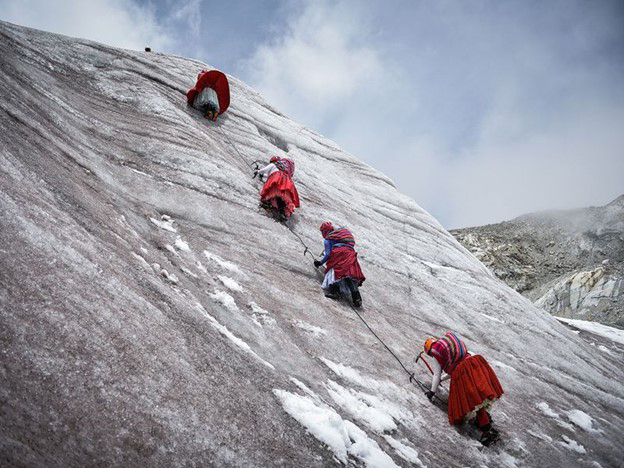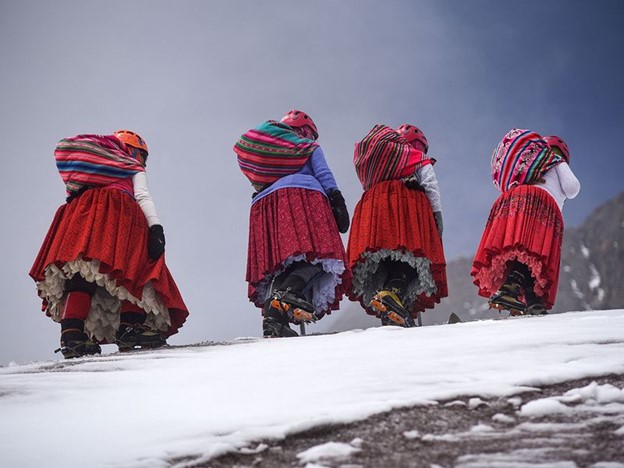Uppity Women
When they first started climbing the Andes peaks, they could hear the ice crunching under their crampons. These days, it’s the sound of melted water running beneath their feet that they mostly listen to as they make their ascents. Dressed in colorful, multilayered skirts, a group of 20 Indigenous Bolivian women — known as the Cholita climbers — have been climbing the mountain range for the past eight years, working as tourist guide suppliers. Julia Quispe Tincuta remembers the first time she reached the peak of Bolivia’s Huayna Potosi mountain, where she and other Aymara Indigenous women had long worked cooking or carrying gear for other climbers to reach base camp. “When I arrived at the summit, I felt like I was in the air, like being in heaven,” the 35-year-old said as she again ascended the nearly 20,000 foot level with a small group, all wearing traditional “cholita” garb with billowing red skirts and carrying their belongings in colorful blankets. “From the mountain I saw the lights of the city of La Paz shining like stars. I thought at that moment that I am never going to stop climbing.” Spurning modern mountaineering gear, the cholitas climb wearing their layered skirts and cardigans — although they do swap their bowler hats for climbing helmets and add crampons to their shoes. They say they have conquered Argentina’s Aconcagua, the highest peak in the Americas at 22,838 feet, as well as the Ojos del Salado, the world’s highest volcano, on the Chile-Argentina border. Now they are training — and looking for financial backing — to climb an even higher peak: Everest.
For years, Lydia Huayllas, 48, has worked as a cook at base camps and mountain-climbing refuges on the steep, glacial slopes of Huayna Potosi, a 19,974 foot Andean peak outside of the Bolivian administrative capital, La Paz. But two years ago, she and 10 other Aymara indigenous women, ages 42 to 50 put on crampons – spikes fixed to a boot for climbing – under their wide traditional skirts and started to do their own climbing. These women have now scaled five peaks – Acotango, Parinacota, Pomarapi and Huayna Potosí as well as Illimani, the highest of all – in Bolivia’s Cordillera Real range. All are higher than 19,500 feet above sea level.
“I want to be the first woman in a skirt to reach the top of Everest, because I want to wave our skirts and the flag of Bolivia,” said Elena Quispe Tincuta, Julia’s sister. The cholitas say their long experience living at high altitude and carrying heavy weight would help them if they can make it to the Himalayas. Elena said the group felt an affinity with the Sherpas who guide foreign climbers to Everest. “I would like to meet the Sherpas and share our stories of the mountains,” she said. “I would like to be there, to meet their animals, the yaks. The Sherpas are almost the same as us.”
Mountain climbing mirth
The reason I climb mountains is because they are there.
That is the reason everyone else goes around them.
Mountain climbers do so much climbing
Don’t they Everest?
I just finished this book on climbing Mt. Everest. Now I’m no mountain climber, but I smoke and I live on the third floor, so I can kind of relate. Everest is a lot like laundry day.
The first person to make a mountain out of a molehill was probably a real estate agent.
March 12th Birthdays
1946 – Lisa Minelli, 1932 – Barabara Feldon, 1987 – Jamie Alexander
1922 – Jack Kerouac, 1960 – Jason Beghe, 1948 – James Taylor, 1982 – Samm Levine




